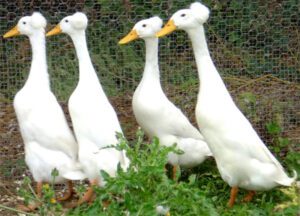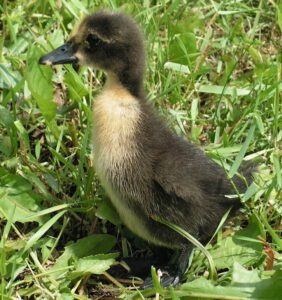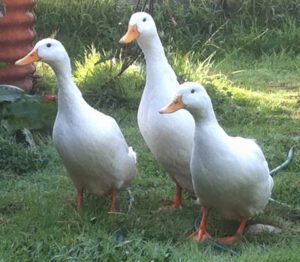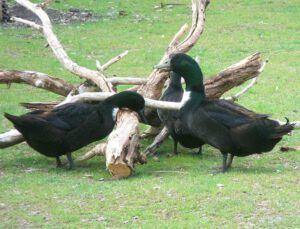The Mallard duck or wild duck is thought to be the most abundant and wide ranging duck on earth. Mallard duck belongs to the subfamity Anatinae of the waterfowl family Anatidae.
This ducks are the ancestor of all of our domestic duck breeds, except the Muscovy duck. The Mallard is a dabbling duck which breeds throughout the temperate and subtropical Americas, Asia, North Africa and Europe. They have been introduced to Australia, Argentina, Brazil, Chile, New Zealand, Peru, South Africa, Uruguay and the Falkland Islands.
Actually the Mallard duck is native to many countries. And they are best known and possibly the most abundant wild duck. Mallard duck is a very common sight in urban ponds, lakes and parks and other man-made water features in the regions they inhabit.
Mallard originally referred to any wild drake/male duck and it is sometimes still used this way. It was derived from the Old French malart or mallart for ‘wild drake’. Although the true derivation of the Mallards is unclear.
Mallard duck is also known as Canard colvert in French and Pato de collar in Spanish. Probably it is related to, or at least influenced by an Old High German masculine proper name Madelhart, clues lying ‘maudelard’ or ‘mawdelard’, the alternate English forms.
Masle/male has also been proposed as an influence. Today the number of Mallard duck is reducing due to excessive hunting and lack of wetlands. But it is still the most common and most abundant duck on Earth.
Mallard Duck Characteristics
The Mallard duck is classed as a medium sized duck. Although it is often slightly heavier than most other dabbling duck. Dabbling ducks are fed mainly at the surface rather than by diving.
Mallard duck is 50 to 65 cm long and has a wingspan of 81 to 98 cm. Among standard measurements, the bill is 4.4-6.1 cm, the tarsus is 4.1-4.8 cm and the wing chord is 25.7-30.6 cm.
The breeding Mallard drake has a glossy bottle-green head and white collar. This white collar demarcates the head from the purple-tinged brown breast, a pale grey belly and grey brown wings.
The drakes have black rear with the dark tail having white borders. The drake’s bill is a yellowish orange tipped with black. But the bill of the female Mallard is generally darker, ranging from black to mottled orange.
The female Mallard is predominantly mottled with each individual feather showing sharp contrast from buff to very dark brown. Such coloration is shared by most of the female dabbling ducks.
And the female Mallards have buff cheeks, eyebrow, throat and neck with darker crown and eye stripe. Both Mallard duck and drakes have distinct iridescent purple blue speculum feathers. And these feathers edged with white, prominent at rest or in flight (though temporarily shed during the annual summer molt).
Immediately after hatching, plumage coloring of the duckling is yellow on the underside and face with streaks by the eyes. And black on the back with some yellow spots, all the way to the top and back of the head. The legs and bill of the ducklings are also of black color.
Plumage of the duckling will start becoming drab after one month, looking more like the female. Although it’s plumage is more streaked. And it’s legs will lose dark grey coloring after one month. The duckling will be a juvenile two months after hatching, and the fledgling period will end.
The juvenile start flying between their three and four months of age, when it’s wings are fully developed for flight. The perfect time of flight for the juvenile can be confirmed by the sight of the purple speculum feathers.
At this stage, their bill will soon lose it’s dark grey coloring and their gender can finally be distinguished visually by three factors.
The breast feathers are brown in females and reddish-brown in drakes. The bill coloring is black and orange for females and is yellow in drakes. And the center tail feather is straight for females, but curled for drakes.

As a small to medium sized waterfowl species, average body weight of the Mallard duck is between 0.72 and 1.58 kg. Photo from Wikipedia.
Uses
The Mallard ducks are wild birds. Usually they are hunted widely. But they are also raised as pets or as ornamental birds.
Special Notes
The Mallard duck is a very beautiful and calm bird. Although they are wild birds, but they are easily domesticated and often group together with other species of ducks. They can live in almost any wetland habitat whether natural or artificial.
And it’s not surprising swimming on lakes, marshes, ponds, coastal habitats, as well as city and suburban parks and in residential backyards. Female Mallards go broody and are excellent mothers. If you are lucky enough, then you can find a Mallard’s nest on your property with some eggs.
Mallard ducks lay an egg every day until they have a full clutch. They usually lay about 8 o 15 eggs. After that the mother will start to sit on her eggs. And like most other ducks, it takes the eggs about 28 days to hatch, from when the duck started sitting all the time.
Upon hatching, the mother will soon lead them to a nearby body of water. The drakes or father do nothing in caring for the eggs or the young.
The Mallard duck is omnivorous and usually take a wide variety of food. The majority of the Mallard duck’s diet seems to be made up of invertebrates (which include flies, beetles, dragonflies, lepidopterans and caddisflies), gastropods, worms, crustaceans, many varieties of seeds and plant matter, and roots and tubers.
Average lifespan of Mallard duck in the wild is 5 to 10 years. However, review full breed profile of the Mallard duck in the following chart.
| Breed Name | Mallard |
| Other Name | Canard colvert in French and Pato de collar in Spanish |
| Breed Purpose | Ornamental, Pets |
| Special Notes | Calm, Excellent Foragers, Good as Pets, Excellent Mothers |
| Breed Class | Light |
| Broodiness | Excellent |
| Weight | 0.72 to 1.58 kg |
| Climate Tolerance | All Climates |
| Egg Color | Eggs color vary from creamy white, pale blue to blue-green without markings |
| Egg Size | Large |
| Egg Weight | 65-75 grams |
| Egg Productivity | Low |
| Flying Ability | Excellent |
| Rarity | Common (thought to be the most abundant duck on Earth) |
| Varieties | A Mallard green head, back rump and yellow bill. Sometimes they can also be Snowy or White |
| Country of Origin | Wild duck species. Native to many countries, but are most abundant duck in North America |
Mallard Duck Facts
Mallard ducks are a common and widespread species of wild ducks that are known for their colorful plumage and distinctive quacking call. Here, we will explore the best Mallard duck facts, from their history and appearance to their behavior and conservation status.
- Mallard ducks are native to North America, Europe, and Asia.
- They are a medium-sized species of duck, with males weighing between 1.5-3 pounds and females weighing between 1-2 pounds.
- Mallard ducks have distinctive iridescent green heads and necks, white neck rings, and chestnut-colored breasts.
- They have a wingspan of 32-39 inches and can fly at speeds of up to 55 miles per hour.
- Mallard ducks are omnivores and eat a variety of foods, including insects, plants, and small fish.
- They have a lifespan of 5-10 years in the wild, depending on their environment and predators.
- Mallard ducks are social animals and live in flocks during the breeding season.
- They are a migratory species and travel long distances to breed and winter in different locations.
- Mallard ducks have a distinctive quacking call, which is used to communicate with other ducks.
- They are a popular game bird and are hunted for sport and food.
- Mallard ducks are also kept as domesticated ducks for their meat and eggs.
- They are adaptable birds and can live in a variety of habitats, including wetlands, forests, and urban areas.
- Mallard ducks are monogamous and mate for life.
- They breed during the spring and summer months and build nests on the ground near water.
- Mallard duck eggs take approximately 28 days to hatch, and ducklings are able to swim and feed themselves shortly after hatching.
- Mallard ducks are important to the ecosystem, as they help to control insect populations and spread seeds from plants.
- They are a vulnerable species in some areas due to habitat loss, hunting, and pollution.
- Mallard ducks are also threatened by the introduction of non-native species, such as the Muscovy duck.
- They have a variety of predators, including foxes, raccoons, and birds of prey.
- Mallard ducks are a popular subject for artists and photographers due to their colorful plumage and distinctive appearance.
- They are protected by law in many countries and cannot be hunted or captured without a permit.
- Mallard ducks are a common sight in parks and urban areas, where they are often fed by people.
- They are known to exhibit a behavior called “head-bobbing,” where they rapidly bob their heads up and down while foraging for food.
- Mallard ducks are a fascinating and important species of wild duck that play a vital role in their ecosystems. Their distinctive appearance and behavior make them a favorite of bird watchers and nature enthusiasts alike.
Tips for Raising Mallard Ducks
Here are the best tips for raising Mallard ducks, from feeding and housing to breeding and health care.
- Provide your Mallard ducks with a clean and spacious living space. They require plenty of room to move around and exercise.
- Provide your Mallard ducks with a comfortable and soft surface to rest on, such as straw or wood shavings.
- Make sure to provide your Mallard ducks with plenty of fresh water at all times. They also require a balanced diet of high-quality duck feed and fresh vegetables.
- Monitor your Mallard ducks’ health closely and seek veterinary care if you notice any changes or signs of illness.
- Keep your Mallard ducks’ living space clean and free of any hazards or potential dangers, such as sharp objects or toxic substances.
- Provide your Mallard ducks with plenty of mental and physical stimulation, such as toys and exercise opportunities.
- Train your Mallard ducks to return to their home base or coop. This is important for their safety and to prevent them from getting lost.
- Make sure to provide your Mallard ducks with plenty of shade and fresh water when they are outside.
- Provide your Mallard ducks with a safe and secure outdoor space to play and exercise.
- Avoid exposing your Mallard ducks to extreme temperatures, as they can be prone to heat stroke and hypothermia.
- Keep your Mallard ducks’ living space free of any drafts or cold air currents.
- Provide your Mallard ducks with a nesting area or coop for breeding.
- Monitor your Mallard ducks’ breeding behavior closely, and separate males and females when necessary to prevent over-breeding.
- Avoid breeding Mallard ducks that are closely related, as this can lead to genetic problems and health issues.
- Provide your Mallard ducks with a balanced diet that includes plenty of fresh vegetables and high-quality duck feed.
- Avoid overfeeding your Mallard ducks, as this can lead to obesity and health problems.
- Provide your Mallard ducks with a variety of perches and swimming areas to keep them mentally and physically stimulated.
- Make sure to provide your Mallard ducks with a clean and dry living space to prevent disease and infection.
- Provide your Mallard ducks with a nesting box or platform to encourage breeding behavior.
- Keep your Mallard ducks’ vaccinations and parasite prevention up to date to prevent illness and disease.
- Monitor your Mallard ducks’ behavior closely, and seek veterinary care if you notice any signs of aggression or unusual behavior.
- Make sure to provide your Mallard ducks with plenty of attention and affection, as they are social animals that thrive on companionship.
- If raising Mallard ducks for meat or eggs, make sure to follow proper slaughtering and processing procedures to ensure food safety.
- Always check local laws and regulations regarding raising Mallard ducks, as some areas may have restrictions or regulations in place.





